skip to main |
skip to sidebar
I'm BAAAAAAAAAAACK! At least for today. This recipe is more for the salad dressing than the salad itself. You can use whatever salad vegetables you like, that you would eat raw. Mine had shredded carrots and beetroot, rocket (arugula), baby spinach, some lettuce of the red-veined variety (who knows what it's called!), tomato wedges, cucumber slices and of course boiled eggs.
Oh, and please ignore the rather gruesome grey-green ring around the yolks. I'm usually pretty deft at getting a perfectly yellow-yolk in my boiled egg, but it so happened that I completely forgot that I had eggs simmering away on the hob. I was distracted by a Facebook status and got sucked in, as you do. I don't know about you, but I blame Mark Zuckerberg. I was loath to throw the eggs away for this blemish and, besides, the green-ringed yolks aren't harmful to eat. So there you have it. By the way, the dressing works rather well with the eggs. I wouldn't have thought it, to be fair.
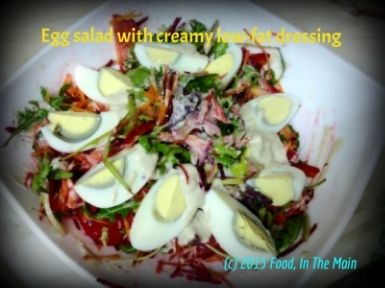
Recipe for: Egg salad with creamy salad dressing
Ingredients
For the salad dressing:
1 tbsp low-fat mayonnaise
4 tbsp Greek or natural yogurt (not sour)
1 htbsp grated parmesan cheese
1.5 tsp Worcestershire sauce
1 tsp lime juice
1 small garlic clove, grated
Freshly ground pepper
pinch of salt
pinch of smoked paprika
For the salad:
1 cup shredded carrots
1/2 cup shredded beetroot
2 medium tomatoes, quartered OR 10-15 cherry tomatoes, halved
1/2 cup cucumber slices
Generous mixture of salad leaves as desired
4 boiled eggs, peeled and quartered
Method:
1. Whisk all the ingredients for the dressing in a bowl. Thin it with a little water, whisking it in, until the dressing is thick but pourable. Adjust the ingredients as required till it tastes good to you. Chill the dressing until required.
2. Put all the salad ingredients in a large bowl and toss them together until evenly distributed. Just before serving, divide the contents between two bowls and dollop most of the dressing over. Mix it into the salad lightly and carefully with your hands fingers or using salad "hands". Place the quartered eggs on top, dab with the remaining dressing and serve at once.
And by that I mean Nupur's version of Madhur Jaffrey's lubia polo. Ever since I read about the Persian dried limes, my one ambition was to somehow source it so that I could make this dish. I didnt want to use lime juice - how boring! So finally I came across a website that sold ingredients for Iraqi, Iranian, Turkish and other such exotic cuisine, so I lavishly ordered away. And in a few days, a little neatly packed box arrived all the way from - er, Germany, actually. Preserved limes, dried lime, dried lime powder - all of these are now in my possession. I have to tell you, the dried lime smells mouth-watering - like neer elumichangai that has ever so slightly fermented.
Anyway, with the dried lime and the dried lime powder (using which is a lot less finicky work than manually separating the black bits from the whole dried limes, I can tell you), I made lubia polo.
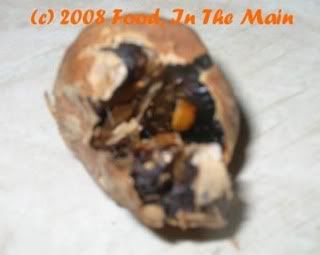
Dried lime tapped open with a hammer
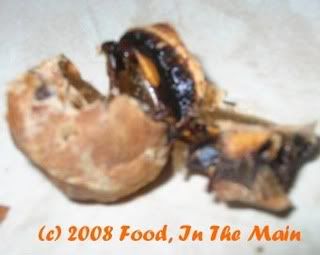
Then pulled apart by hand

The black interior contents scraped out (on the right) and the discarded lime peel (left)

Readymade powdered dried lime - a much simpler option
And then I suddenly realised that the post had been hanging fire for at least 10 days, and it would be perfect for Zlamushka's "Tried and Tasted" event that's currently happening - assuming I'm not too late with my offering.
This baked green-bean and potato rice has the least amount of spices and seasoning that I've ever seen... and yet the end result is so INCREDIBLY flavourful! I followed pretty much the same method as Nupur, except that instead of garam masala I used a couple of pinches of my extremely potent, aromatic, home-made dhansak masala!
I have to admit that my lubia polo did not turn out as beautifully shaped as Nupur's, nor did it hold together nicely. But that was because I didnt - dont - have the right-shaped non-stick pan, nor even a heavy-bottomed non-non-stick (how else do you say it?) pan... so I improvised with a shallow vessel I use in the pressure cooker. It was too thin so the potato slices at the bottom got a bit burnt and the rice didnt get a chance to crisp up. But, like I said, it was fantastically tasty, even if not picture-perfect to look at. In any case, if you're looking for picture perfection, the blog to go to is Nupur's! :)
Recipe for: Nupur's lubia polo
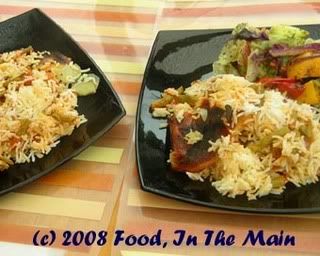
Ingredients:
1 cup basmati rice, washed and soaked for 15 minutes
2 cups green beans, halved
1 onion, chopped
1 potato, peeled and sliced thin
1/2 cup tomato puree
1/2 tsp turmeric
1 tbsp olive oil
1 tsp butter
Salt to taste
1 tsp garam masala/pav bhaji masala/dhansak masala
1 htsp powdered dried lime OR 1 tbsp fresh lime juice
Method:
1. Boil the rice in 2 cups of lightly salted water till almost done. Drain well and reserve.
2. Heat the olive oil in a skillet and fry the chopped onion till soft and light brown.
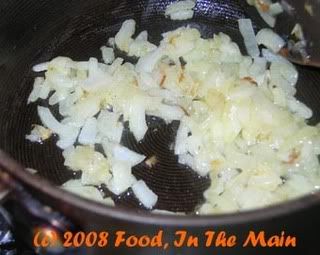
3. Add the green beans and saute for a few minutes,
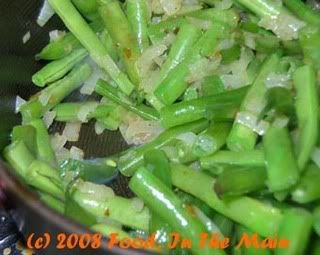
then add the tomato puree and whichever masala you're using.
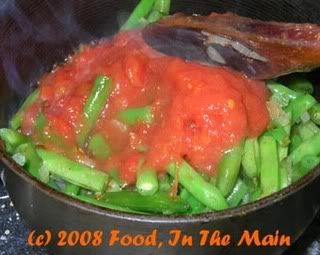
4. Simmer the beans till tender, then add salt to taste. The sauce should be fairly thick now. Add 1 heaped tsp dried lime powder, mix and set aside.
5. In a medium deep non-stick pan, melt 1 tsp butter. Stir in 1/2 tsp turmeric and water. Layer the bottom of the pan with the thinly sliced potato.
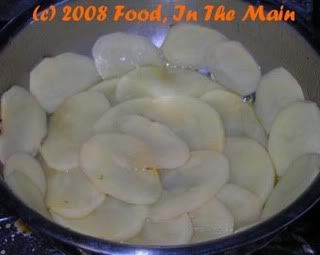
6. Put half the rice over the potatoes,
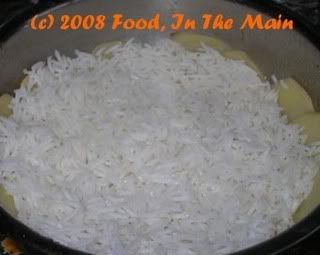
then pour over the green bean mixture,

and finally the rest of the rice.
7. Cover the pan and leave on medium heat for 10 minutes, then lower the heat to its lowest point.
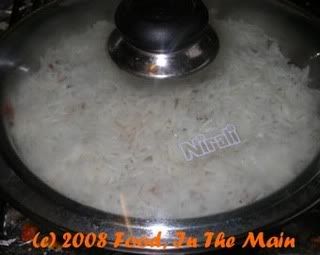
Place a clean dish towel under the lid and fold the hanging edges back on top of the lid.
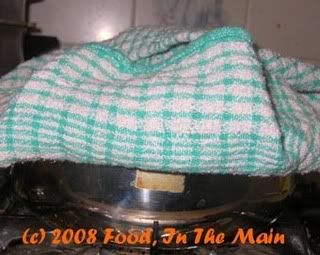
9. Cook on low heat for 20 minutes or so, then let the pilaf rest for 10 minutes.
10. After the resting time, invert the pan onto a serving dish. The pilaf should unmold itself whole - but if it doesnt (like mine) dont worry... it will still taste delicious!
 Ever heard of this cake? No? Really? All you fantastic cooks out there, you’ve never made this cake? Not even heard of it? Really? How very strange…
Ever heard of this cake? No? Really? All you fantastic cooks out there, you’ve never made this cake? Not even heard of it? Really? How very strange…
Ok, not so strange. Because I made it up The cake is just a pound cake with the ingredients halved because I could not bring myself to use four eggs in one cake. Plus the cake would have been wayyyy too large, even with the kids at home. So, I reduced all the ingredients by half – basically making a half-pound cake.
Then where did the “10 shilling” tag come from, you ask? Aha. Therein lies a very sad little play on words – mmmm... shall we say that I coined it? Ahahahaha!
Ok, here it comes. I’m guessing most of you know that before British pound went decimal in 1971, it was divided into twenty shillings and each shilling was divided into twelve pennies or pence. Although those divisions may seem odd, in fact having a pound divided into 240 equal parts does mean it can be exactly divided into halves, thirds, quarters, fifths, sixths, eighths, tenths, twelfths, fifteenths, sixteenths, twentieths, twenty-fourths, thirtieths, fortieths, forty-eightieths, sixtieths, eightieths, and one-hundred-and-twentieths. A decimal system allows precise division only into halves, quarters, fifths, tenths, twentieths, twenty-fifths, and fiftieths.
(If you math buffs want more of this sort of drivel, you can find the rest of it here.)
Guesses about the origin of the coined title, anybody? No? (I'm assuming no. I Want To Explain. I Have To Explain. How Else Could Anybody Appreciate This Exquisite Sense of Humour and Play on Words?) Ok, here's the explanation. A pound is 20 shillings, or used to be. Half of a pound is 10 shillings. Half of a pound cake, therefore, becomes...? Yes! A 10-shilling cake! Ta-DAAAA!
This 10-shilling cake was lucky to have come out as lovely as it did because in a fit of absentmindedness, instead of adding the butter to the bowl containing sugar (prior to beating the two till light and creamy), I plopped the butter into the bowl in which the egss were waiting to be beaten. Oooops!

Well, in for a penny, in for a pound (or a half-pound, or even 10 shillings! ahahahaha!), so I just tipped the sugar into the egg-butter mixture and beat the resulting mixture to within an inch of its life. It must have learnt its lesson, because the cake was light and crumby and delightfully lemony. Sometimes mistakes CAN be sammaLichufied (Tanglish - Tamil English - for "managed" or "made good").
Recipe for: Lemon 10-shilling cake

Ingredients:
1/2 cup butter, softened
1 cup sugar
2 eggs
1 tsp vanilla
1-1/2cups sifted flour
1/4 tsp. baking powder
1/4 tsp. baking soda
1/8 tsp. salt
1/2 cup buttermilk
Juice of one lemon
Icing:
1 cup icing sugar
Enough lemon juice to make thick or runny icing as per taste
Method:
1. Preheat oven to 170C. Spray a small (6") bundt pan with Pam, wipe off the excess, and set aside.
2. In large mixing bowl, beat butter with sugar and eggs vigorously, until the batter is light and frothy.

3. Sift together flour, baking powder, soda, and salt.
4. Add to butter mixture alternately with buttermilk and lemon juice, beginning and ending with flour.
5. Spoon batter into prepared pan and bake at 170C for 55-65 minutes until cake is lightly browned, set, and a toothpick inserted in the centre comes out clean.

6. Cool 5 minutes in pan, then invert onto serving plate and cool completely.
7. Mix icing sugar with lemon juice, then drizzle over the warm cake.

Let cool to set.





















